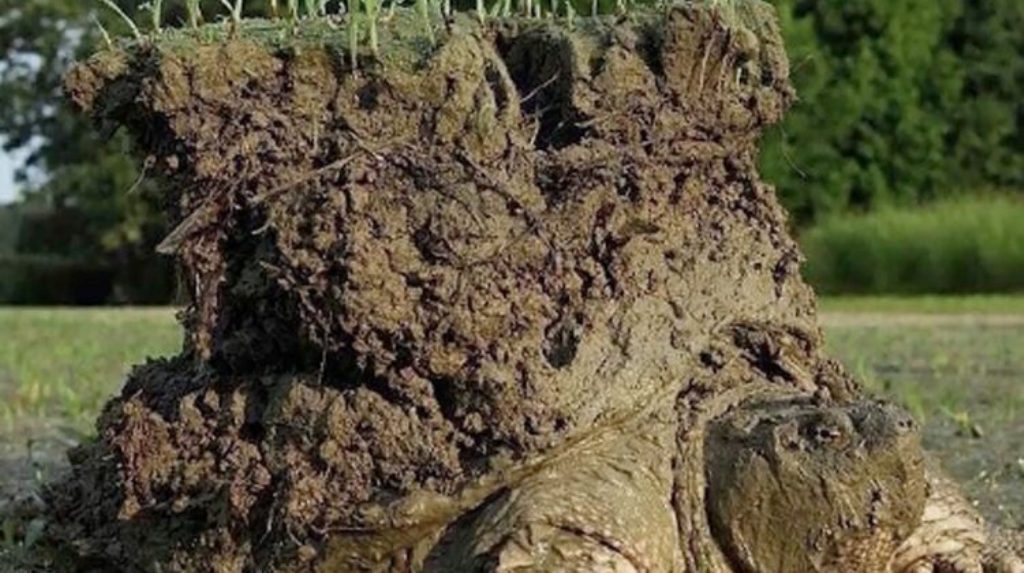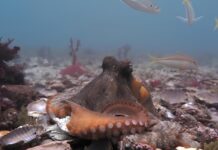Galileo was wrong, and ancient cosmologists were correct: this turtle carries the entire planet on its back.
When the aforementioned photograph was circulated on Twitter earlier this week, Live Science spotted it and contacted Task Force Turtle to learn more. The complete narrative turns out to contain drugs, riddles, incredible herpetological memories, butt gas, and maybe the ability to hold one’s turtle-like breath for months on end.
For more than a decade, Task Force Turtle, a collaboration of herpetologists and undergraduate students from Washington College and other local institutions, has been meticulously following snappers and painted turtles in Maryland marshes. The common snapping turtle in the image is one of several snappers and painted turtles discovered by Task Force Turtle.

“All of our turtles, thousands of them now, have been fitted with radio transmitters in the summertime when they’re making these movements [toward their winter mud holes],” said Aaron R. Krochmal, a biology professor at Washington College and one of the researchers who launched the experiment. We literally “follow” them around the clock.
He claims that the turtles in the region are intriguing because they allow experts to properly investigate a migration. Year after year, turtles take the same journey from their summer stomping grounds to their winter hideouts—tightly packed, subterranean mud-holes where they may wait out the cold.
“What we find fascinating is that these animals wallow in a specific area of mud.” And they return year after year to the exact same spot, which I characterize as being precise to the centimeter,” Krochmal explained.
According to him, this is a once-in-a-lifetime chance for researchers to perform a comprehensive study of an annual migration, allowing them to engage with the turtles in ways that are just not conceivable when an Arctic tern or bison herd is in motion.
The researchers get up up and personal with their victims, even going so far as to put “turtle-cams” on their backs to capture their movements.
Check out this HD (check your settings!) snippet from #SNAPPERCAM – a female snapping #turtle, navigating through her swampy home! Footage like this is teaching us tons about #cognition, #behavior, and #ecology in wild turtles! A big win for #herpetology! pic.twitter.com/vYi7bfuymT
— Task Force Turtle (@TaskForceTurtle) July 12, 2018
Krochmal said that the turtle with a miniature living environment on its back had not simply emerged from hibernation. She had actually been immersed in muck for more than two weeks beside a dried-up lake.
“We weren’t actually convinced that her radio transmitter was still attached,” Krochmal stated.
While the rest of the others had already moved on to their winter homes, this turtle was firmly buried and showed no indications of surfacing. Perhaps she had already fled, taking her transmitter with her.
At that time, the earth began to tremor, and she emerged writhing. Timothy Roth, a psychology professor at Franklin & Marshall College, took the photograph.
According to Krochmal, the 10-inch-thick (25-centimeter) planet on the turtle’s back weighted around 18 pounds, while the turtle weighed about 13 pounds (6 kilograms). (8 kg). But she made no evident effort as she started out for her winter muck hole. [Top 10 Most Amazing Animal Expeditions]
“She was just trucking right along,” he commented.
Krochmal, Roth, and their colleagues are fascinated to these critters because they always walk the same path to the same mud hole. He claimed that it is simply unknown how typical this mud-hole migration is elsewhere in Maryland. While it’s probable that the reptiles rely on pockets of air below and are known to severely slow down their metabolic rates and swallow air bubbles via their mouths and cloacas, it’s unknown how they may go months without coming out for breath. (turtley anus-genital combination holes).
However, the Turtle Task Force is progressively finding out what is going on in the critters’ thoughts to allow them to repeat such a similar trek every year, he added.
He said that as part of that attempt, migrating turtles were given scopolamine doses.
According to him, scopolamine stops the brain from binding the neurotransmitter acetylcholine.
This eliminates the ability of the brain to produce or access memories. (Previously, physicians administered it to women after childbirth, but that’s another tale.)
The medicine causes migratory turtles to become disoriented, according to the study.
“They just sort of wander in circles for about five or six hours until the drug wears off,” Krochmal added. Then they just “snap out of it,” return to their planned path, and continue on their way.
This is a story about how turtle brains interpret information to manage their brief yearly voyage back and forth, according to the experts. For the turtles, it is a story of perseverance in the face of odd substances injected into their bodies or massive loads weighing down on them.






